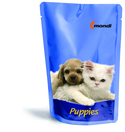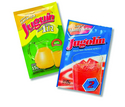Building up the barriers
1 December 2009Although the development of innovative flexible film applications might have temporarily gone onto the back-burner, demand for high performance barrier packaging remains as strong as ever. But what is it being made of?, asks Sam Cole
Brand owners might have spent the past year in maintaining a watchful eye over budgets, but if there’s one type of application that’s proving to be relatively immune to catching a cold in the current economic climate it is barrier film packaging - geared towards extending on-shelf life expectancy and greater consumer protection.
According to the recent Pira report: The Future of Speciality Films Market Forecasts to 2014, barrier films have represented over 50% of all speciality grades this year. It’s a global market valued at €8.1 billion and predicted to rise to just under €10 billion over the next five years.
On-going demand primarily for oxygen/gas and moisture barrier high value applications has attracted considerable levels of investment; for example, Toray Industries’ pending 10 million yen extension into France scheduled to become operational next year with a targeted production output of around 20,000 tonnes of metallised BOPP film for the European market.
“Whilst the European market for flexibles has experienced a fall in volumes of around 5% this year – with consolidation having replaced innovation for many manufacturers - barrier applications have largely withstood that downward pressure,” notes industry consultant Neil Farmer, whose company, Neil Farmer Associates, monitors trends across the flexible sector.
“Consumers want packaging that keeps products in good condition; ultimately they want products that offer security, and that are fresh and ready to be eaten. To achieve that you’ve got to have better barrier for longer shelf life; that’s what it’s all about. If it costs a bit more, then so be it. The expansion of the laminated stand-up pouch market has been phenomenal, with an annual predicted growth rate of 10% over the next three years. Even more impressive has been the adoption of intelligent packaging applications, which are reckoned to be growing by 30% per annum.”
By definition, barrier films will be co-extruded structures usually incorporating anything from two to five different layers subject to specific application requirements: laminates with several grades glued together, or else coated films. Given the self-evident difficulties in efficiently recycling these constructions, a number of compostable or biodegradable alternatives are also beginning to challenge for market share – although they too are under-served by the existing waste recovery infrastructure.
Film going it alone
In the main, polyamides (nylon) and PET provide the best barrier to air, whilst polypropylene (PP) or polyethylene (PE) is the preferred barrier for repelling moisture. Increasingly used is a PVdC coating which has the capability to provide a barrier against both.
Atypical co-extrusions have traditionally incorporated an aluminium foil layer: for example, the three-layer pouch developed for the burgeoning pet food market by Mondi Flexibles, which sandwiches foil between PE on the outside and PP for the inner, where a very heat-resistant sealing is required.
The pouch is filled at ambient room temperature and once closed goes into an autoclave at a standard 120degC for about 40min in order to eliminate any possible micro-organisms. It can then be stored on the shelf for more than a year, if necessary.
However, ExxonMobil Chemical has proved that film technology can provide a complete solution by claiming that compared to thin aluminium foils, Metallyte OPP films enhance packaging performance because the biaxial orientation process provides high puncture and flex-crack resistance.
Increased puncture resistance also helps prevent sharp ingredients, such as coffee beans, grains, noodles and croutons, from perforating the foil layer. As a result, product-induced barrier losses, which can be a problem with aluminium foil, are minimised. Meanwhile, enhanced flex-crack resistance ensures increased barrier integrity of the package.
“With stand-up bags and pouches proliferating in response to an increasing consumer demand for convenience, the performance advantages of Metallyte OPP films are creating new opportunities,” says films global market segment manager Paul Smeaton. He also notes that new enhanced sealant technology is also helping Metallyte to meet lightweighting criteria, whilst coming close to strengths comparable to that of extrusion-coated polyolefin sealants and thinner cast or blown polyolefin sealant films.
“The combination of these outstanding sealant and barrier technologies provides new opportunities for structure simplification, enabling the packaging weight to be reduced significantly by using just two layers rather than the usual three.”
Depending on the aluminium foil packaging being replaced, structure simplification using Metallyte UBW-ES: a white opaque OPP film that provides exceptional oxygen, aroma and moisture barrier that also replaces extruded coated PE and delivers high seal strength, can result in total weight reductions of up to 30%.
Brückner has also gone down the metallised route with its thin, ultra-high barrier BOPP films achieving improved barrier values, with oxygen transmission rate OTR values of 0.2 cm³/m² d bar (23degC/75% RH). According to corporate communications manager Karlheinz Weinmann, these approach those of aluminium foil as well as being 250 times lower than that of standard BOPP metalised films, which are in the range of 40-70 cm³/ m² d bar.
“Aluminium foil is essentially impenetrable by moisture and oxygen. However, when packages made with foil are subjected to the repeated manipulation and handling that are common with manufacturing, shelf stocking and consumer handling in the retail environment, they can develop pinholes and become permeable. An additional reason for replacing thin aluminium foil with metallised BOPP ultra-high barrier films is ever-increasing material prices and the fact that thin foils have a thickness of 7 micron, whereas the aluminium coatings on BOPP films are in a thickness range of 40-60nm.”
Whilst some film producers are naturally bullish about their capabilities, Alcan Packaging Food Europe’s director of product sustainability, Dr Gerald Rebitzer, insists that co-extrusions incorporating an aluminium foil layer have their place in the barrier protection hierarchy.
“There’s rarely going to be on material fit for all purposes. It all depends upon what barrier properties are required. In some applications – for example, where there’s a high aroma factor – nothing can beat aluminium. However, there are also many applications which will have incorporated aluminium in the past, but where it’s been substituted with technologically advanced film or coating,” he says.
”In Switzerland, there was a trend some years ago to replace foil in confectionery packaging with a coated plastics. What happened was that most manufacturers, particularly at the high end, reverted back to aluminium solutions because the film alternative wasn’t achieving comparable quality and protection.”
Even so, Alcan Packaging Food Europe’s Ceramis transparent coating - a thin inorganic layer of silicon oxide (SiOx) evaporated in a vacuum environment to substrates like PET and BOPP - has facilitated a growing number of film-only barrier solutions; for example, modified atmosphere (MAP) applications; stand-up pouches; lidding for retort products; and flow packs. It is also microwave compatible.
“It provides very good barrier properties with a low environmental impact,’ notes Dr Rebitzer. ‘And by improving film performance in application it means that less material is required as a direct result; an important environmental gain.
”Barriers to sustainability
According to Dr Rebitzer, it wouldn’t make any commercial sense from a performance perspective to combine silicon oxide coated polymers and foil within a barrier co-extrusion.
Another no-go area for aluminium is the developing market for biodegradable film barrier applications – whereas a SiOx coating such as Ceramis can be equally applied to films manufactured from renewable resources, it has a particular affinity to polylactic acid base materials (PLA) in helping to withstand both oxygen and moisture.
Innovia’s cellulose-based NatureFlex NM metallised film manufactured from wood pulp – affording good moisture and aroma barrier protection – is steadily building market share via brands reflecting high sustainability credentials; for example, its recent adoption by the Canadian-based Dr Vie range of nutritional ‘superfoods’.
With less than 0.2% metal content, NatureFlex NM is said to be the only metallised biodegradable film suitable for home composting; only slowing biodegradation by a matter of days. Modified coatings ensure excellentmetal laydown and adhesion, providing a very high moisture barrier with a transmission rate of less than 10g/m²/day (380C, 90% RH).
“Our coating technology allows us to use small amounts of different material to reinforce the barrier without compromising the bio-degradability,” says Innovia Films director Andy Sweetman. “You can work with very small amounts; they must be non-toxic, and there’s a very rigorous testing programme to be gone through to prove that the overall solution is biodegradable, compostable and has no toxicity issues.”
There are, however, still levels of barrier protection that only aluminium foil solutions can provide. Although only a small proportion of API Laminates’ annual production of 100 million m² of aluminium foil goes to barrier applications, confirms director Simon Thompson, the company has recently started to supply the necessary shielding technology to ensure that the new breed of contactless credit cards being adopted by most leading financial institutions are fully secure when not in use.
Whilst it’s not a packaging application per se, it’s a tangible reminder of the substrate’s capability to guarantee the optimum barrier – and one that could transfer into the flexible sector as a new generation of intelligent solutions comes on stream.
Co-extruded stand-up pouch for pet food (Mondi Flexibles) Mondi Flexibles Exxon Mobil Chemical Metallyte barrier film application Exxon Mobil External weblinksConverting Today is not responsible for the content of external internet sites.Alcan Packaging Food Europe API Laminates Brückner Maschinenbau Exxon Mobil Chemical Innovia Films Mondi Flexibles



